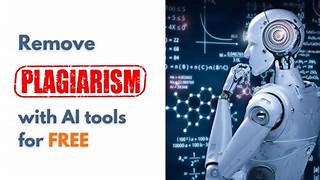AI-Driven Plagiarism Detection in Academic Writing: A Comprehensive Analysis
Plagiarism is a longstanding challenge in academia, threatening the integrity of research, writing, and intellectual property. With the advent of digital resources and easy access to vast amounts of information, the issue has become more pervasive. However, technology has also offered solutions to this problem. Artificial Intelligence (AI)-driven plagiarism detection systems have emerged as a powerful tool in ensuring the authenticity of academic writing. These systems are transforming how plagiarism is identified and prevented, enhancing the quality of scholarly work.
This article explores the role of AI in plagiarism detection, the mechanisms behind it, its benefits, challenges, and its future in academia.
What Is Plagiarism and Why Is It a Problem?
Plagiarism is the act of using someone else’s work, ideas, or words without proper attribution. It can take many forms, including:
- Direct Plagiarism: Copying text verbatim without acknowledgment.
- Paraphrasing Plagiarism: Rewriting someone else’s work without proper citation.
- Self-Plagiarism: Reusing one’s own previously published work without disclosure.
- Patchwriting: Piecing together text from various sources without original contribution.
The implications of plagiarism in academic writing are significant:
- Erosion of Credibility: It undermines the trustworthiness of academic institutions and individuals.
- Legal and Ethical Consequences: Plagiarism can lead to legal disputes, loss of reputation, and academic penalties.
- Hindrance to Knowledge Development: It stalls genuine innovation and original thought.
The Rise of AI in Plagiarism Detection
Traditional plagiarism detection tools relied on keyword matching and basic text comparison. While effective to some extent, they often missed nuanced cases such as paraphrased text or translations. AI-driven systems, on the other hand, utilize advanced algorithms to overcome these limitations.
How AI-Powered Plagiarism Detection Works
AI-driven plagiarism detection systems incorporate several technologies:
- Natural Language Processing (NLP):
NLP enables machines to understand and analyze text in a way similar to human cognition. It identifies semantic similarities, meaning that even paraphrased or restructured content can be flagged. - Machine Learning (ML):
ML models train on vast datasets of text to recognize patterns of similarity. Over time, these systems improve in identifying subtle forms of plagiarism. - Database Integration:
AI tools access extensive databases, including academic journals, websites, books, and unpublished content, ensuring comprehensive cross-referencing. - Stylometric Analysis:
AI systems can analyze the writing style of a document, comparing it with the known writing style of the author. Abrupt changes in style may indicate copied material. - Multilingual Capabilities:
AI-powered systems can detect plagiarism across different languages, addressing a common loophole in traditional tools.
Benefits of AI-Driven Plagiarism Detection
AI has significantly enhanced the capabilities of plagiarism detection tools, offering numerous advantages to academia:
1. Improved Accuracy
AI tools can detect not only identical matches but also paraphrased or restructured content, providing more accurate results. They reduce false positives and negatives, ensuring that only genuine concerns are flagged.
2. Speed and Efficiency
Unlike manual detection, which is time-consuming and prone to error, AI systems can analyze extensive documents within seconds. This speed is especially valuable in academic settings with high volumes of submissions.
3. Comprehensive Coverage
AI tools leverage vast, ever-expanding databases to compare texts against a wide range of sources, including obscure or unpublished works.
4. Accessibility and Scalability
AI-based tools are accessible to institutions of all sizes and can handle increasing workloads without compromising performance.
5. Educational Value
Beyond detection, many AI tools provide detailed reports, helping students and researchers understand their mistakes and learn proper citation practices.
Challenges and Limitations of AI in Plagiarism Detection
Despite its advantages, AI-driven plagiarism detection faces several challenges:
1. Contextual Understanding
While AI systems excel in identifying textual similarities, they sometimes struggle with context. For instance, correctly cited material or common phrases may be flagged unnecessarily.
2. Data Privacy Concerns
AI tools often upload documents to external servers for analysis. This raises concerns about the privacy and security of sensitive academic work.
3. High Costs
Advanced AI tools can be expensive, limiting access for smaller institutions or individual researchers.
4. Dependence on Databases
The effectiveness of AI tools depends on the size and comprehensiveness of their databases. Content not included in these databases may go undetected.
5. Potential for Over-Reliance
There is a risk that students and researchers may over-rely on AI tools, neglecting to develop their own skills in citation and ethical writing.
Ethical Considerations in AI-Driven Plagiarism Detection
The use of AI in plagiarism detection also raises ethical questions:
- Fair Use: Is it ethical for AI tools to store and compare academic work without explicit consent from the authors?
- Bias in Algorithms: AI systems may inadvertently reflect biases in their training data, leading to uneven detection rates.
- Punitive vs. Educational Approach: Should AI tools be used primarily as punitive measures, or can they serve as learning tools to promote ethical writing?
AI in Action: Real-World Applications
AI-driven plagiarism detection is widely used across academic institutions, publishers, and online platforms. Some popular tools include:
- Turnitin:
A leading tool that incorporates AI to detect nuanced forms of plagiarism. - Grammarly Premium:
Offers plagiarism detection as part of its comprehensive writing assistance. - Copyleaks:
Uses AI to identify plagiarism across languages and writing styles. - Unicheck:
Focuses on integrating with educational platforms to provide seamless detection.
Future Prospects for AI in Plagiarism Detection
The future of AI in plagiarism detection is promising, with advancements expected in several areas:
- Enhanced Contextual Analysis:
Future tools may better understand the context, distinguishing between plagiarism and proper citation. - Blockchain Integration:
Blockchain technology could be used to create immutable records of authorship, reducing the risk of plagiarism. - Real-Time Detection:
AI tools integrated into writing platforms could provide instant feedback, preventing plagiarism during the writing process. - Greater Accessibility:
As AI becomes more widespread, tools may become more affordable and accessible to a broader audience. - Ethical AI Development:
Developers are likely to focus on creating tools that balance detection capabilities with privacy and fairness.
Conclusion
AI-driven plagiarism detection has revolutionized how academic integrity is maintained. These systems offer unparalleled accuracy, speed, and scope, enabling institutions to uphold ethical standards in writing and research. However, challenges such as contextual understanding, data privacy, and ethical considerations must be addressed to ensure the responsible use of AI in this domain.
The ultimate goal should be to foster a culture of integrity and learning, where plagiarism detection tools serve not only as enforcers but also as educators. By leveraging AI responsibly, academia can navigate the complexities of the digital age while preserving the values of originality and ethical scholarship.


